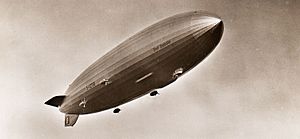LZ 130 Graf Zeppelin facts for kids
The LZ 130 Graf Zeppelin II was a giant airship, the last one built by Germany's Zeppelin company before World War II. It was a sister ship to the famous Hindenburg, meaning they were designed very similarly. However, a big change happened to the Graf Zeppelin II's plans after the Hindenburg disaster.
Contents
Building a Giant Airship
The LZ 130 was built using the same blueprints as the Hindenburg. Construction started in 1936 and finished in 1938. These airships were huge, like flying cities, designed to carry passengers across oceans.
The Hindenburg Disaster's Impact
In May 1937, the Hindenburg airship caught fire and crashed. This terrible event made people very worried about using hydrogen gas, which is highly flammable, to lift airships. Because of this, the LZ 130 was changed to use helium instead.
Helium is a much safer gas because it doesn't burn. However, it's also heavier than hydrogen, so it provides less lift. This meant the Graf Zeppelin II couldn't carry as many passengers. While the Hindenburg could carry 72 people, the Graf Zeppelin II was limited to just 40.
The Helium Problem
Helium was very rare and expensive back then. The main supplier was the United States. Germany tried to buy helium from the U.S., but the U.S. government refused to sell it, especially as tensions grew before World War II.
Because Germany couldn't get helium, the Graf Zeppelin II ended up being filled with hydrogen anyway, just like the Hindenburg. Even so, the airship was built to be very good at not leaking gas, which was important for safety.
First Flights and Missions
The LZ 130 Graf Zeppelin II made its first flight on September 14, 1938. It flew 30 times in total during its short service life. Most of these flights were for testing or for propaganda purposes, showing off Germany's engineering power.
Reconnaissance Flights
As World War II approached, the Graf Zeppelin II was used for secret missions. It flew along the coasts of Great Britain, using special equipment to try and listen in on British radio signals and radar. These were some of the first times airships were used for electronic spying.
End of the Airship Era
The Graf Zeppelin II's career was very short. When World War II began in September 1939, airships were no longer seen as useful for travel or even for military purposes. Airplanes had become much faster and safer.
In April 1940, the Graf Zeppelin II was taken apart. Its metal frame was used to build airplanes for the war effort. Today, a small part of its bow (the front section) is preserved at the Zeppelin Museum Friedrichshafen in Germany, reminding us of these amazing flying giants.
Images for kids
See also
 In Spanish: LZ 130 Graf Zeppelin para niños
In Spanish: LZ 130 Graf Zeppelin para niños





